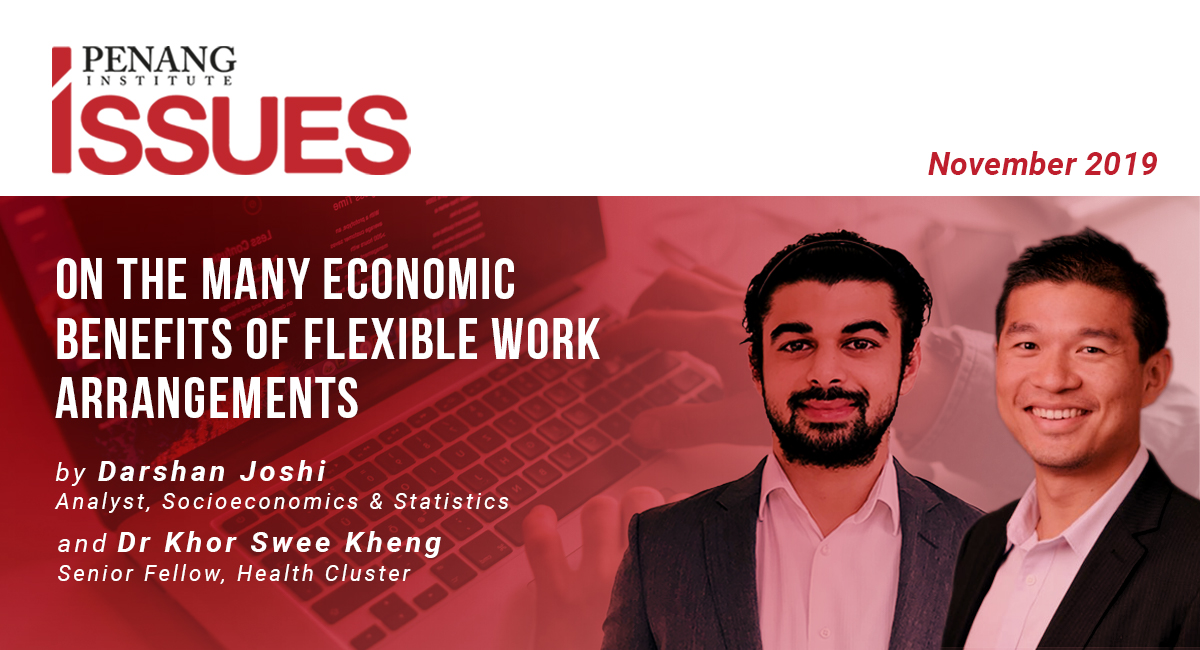- Flexible work arrangements (FWAs), a term which describes any manner of adaptation to the traditional 9-5 office-based work schedule, provoke profound changes to society and its relationship to work
- FWAs are typically employed in order to maximise benefits that accrue to employers or their employees; its provision has been found to positively affect productivity, morale, and workplace satisfaction; and contribute to reductions in cases of absenteeism, attrition, tardiness and the use of sick leave, among other factors
- In addition to these immediate benefits, we postulate that the pervasive adoption of FWAs creates three key positive economic externalities: the encouragement of geographically-decentralised and diversified economic growth; a larger, more accessible, diverse and equitable labour force; and a reduction in the economic costs of traffic congestion
- The presence of these positive externalities creates room for productive and efficiency-improving intervention by policymakers, in promoting and incentivising the wider acceptance and adoption of FWAs as an avenue through which to maximise aggregate social welfare
- Additionally, FWAs create positive non-economic externalities, which we discuss in a separate, forthcoming paper
- We suggest that the Ministry of Human Resources and other relevant agencies work with companies across a spectrum of industries to promote the cause and concept of FWAs which can best serve everyone’s interests
Introduction
Flexible work arrangements (FWAs) undeniably provoke profound changes to society and its relationship to work. While there may be disadvantages, we believe that the myriad advantages of FWAs outweigh any possible drawbacks. The immediate benefits of FWAs accrue to the companies and organisations that promote it, in the form of improved talent acquisition, employee morale and overall productivity.
We propose that FWAs also create positive economic externalities that will be enjoyed by society at large, in the form of geographically-decentralised and diversified economic growth; a larger and more accessible, diverse and equitable labour force; and a reduction in the economic costs of traffic congestion.
The History of Work
Work is central to the existence of human beings. For society, it provides economic growth, delivers goods and services, and allows citizens to be occupied. For individuals, work provides a salary, an identity, a structure to their daily routines, and for those lucky enough, purpose and meaning to their lives. Much has been written about the virtues of work and labour in philosophical, religious and literary texts, yet the nature of our relationship to work has always been evolving over the centuries.
Humanity’s original societies were hunter-gatherers, and they were arguably the most equal of societies. Over time, populations grew and humans required new ways to organise themselves – and grow richer. Until the 1600s, most of humanity still suffered in slavery, whether in direct servitude, as a serf in a feudal society, or in extreme poverty; the more fortunate were self-employed as artisans or merchants. The advent of companies in the 1400-1500s was both a cause and effect of urbanisation, where an increasing number of people became employed by these companies, moved to cities and became dependent on the company for their livelihoods. This economic system is known as capitalism.
Inherent tensions between capitalists (for example, factory owners then and start-up venture capitalists now) and labourers (factory workers then and software developers now) are built into capitalism. Over the past few centuries, the rights of workers became more asserted. During that time, workers worked as many hours as they physically could – or their employers wanted, sometimes up to 100 hours a week. The 40-hour workweek, for example, only came in stages, beginning in the 1860s in the US city of Chicago.[1] Today, some argue for a 35- (like the French) or even a 30-hour workweek.
The length of the workweek is only one example of how society’s relationship with work has evolved. Using this evolutionary perspective, we can posit that the modern nature of work is already being disrupted, as citizens do not need to be physically present at the workplace to provide economic output. Work, like history, does not stand still.
The Future of Work
Traditional approaches to work are already being disrupted by FWAs, an umbrella term for all manners of adaptation to the traditional 9-to-5, 40-hour workweeks spent physically in the office. They can range from differences in the hours, places, or schedules worked[2], and can depend on factors such as employer (type of industry, comfort level of its leadership and Human Resources function, existing labour laws), employee (demographics like age, gender, education level, type of work), technology (broadband speeds, video-conferencing facilities, ability to use technology), and geography (distance to office, average commute time), among others.
In the US, between 1985 and 1997, the share of the workforce with access to flexible working hours, or “flextime”, a key component of a broader set of FWAs, doubled to almost 28%.[3] By 2016, roughly half the employers were offering flextime options. At the same time, 43% of Americans reported having spent at least some time working remotely, up from 39% in 2012[4], with a third of this group doing so at least 80% of the time. In Scandinavia and the Netherlands, over half the labour force is afforded a degree of flexibility in determining their working hours; across the European Union (EU) as a whole, almost a third of employees have such freedom.[5] These trends are not limited to developed nations in the West; across Asia, 52% offer employees the opportunity to take advantage of FWAs.[6]
Malaysia, however, lags behind its counterparts. As of 2015, less than 35% of Malaysian firms reported doing so.[7] While there have been promotive efforts made by some government agencies[8], data on the extent of its adoption are patchy. In all likelihood, Malaysians are missing out on the opportunity to enjoy the full extent of social benefits provided by FWAs.[9]
The increasingly pervasive adoption of FWAs has been enabled by advancements in information and communication technologies (ICT) and connectivity allowing for remote meetings and collaboration. Another factor accelerating the adoption of FWAs is the shift from workplace-based manufacturing output (i.e. factories) towards based-anywhere knowledge services output (i.e. software developers working from home).
The rapid growth of this shift has created significant and positive effects on employers and employees alike. Across various countries and industries, FWAs have been found to positively affect productivity, morale, and workplace satisfaction, and contribute to reductions in cases of absenteeism, attrition, tardiness and the use of sick leave.[10] Coupled with the entrance of millennials into the workforce, for whom the attainment of a healthy work-life balance is an important factor influencing employment decisions[11], FWAs are expected to be ubiquitous over time. The improvements they engender with regard to productivity and efficiency at the firm level ultimately translate into improved local and national economic outcomes more broadly.
Yet while companies are increasingly adopting FWAs to primarily achieve internal benefits for the firm, there exist numerous positive economic externalities to FWAs[12]. Employers, in considering only its privately-realised benefits, are theorised to “underprovide” FWAs since they do not directly reap the benefits of these externalities. This creates room for productive and efficiency-improving intervention by policymakers, in promoting and incentivising the wider acceptance and adoption of FWAs as an avenue through which to maximise aggregate social welfare.[13]
FWAs Encourage Decentralised and Diversified Economic Growth
One common and valid criticism of economic growth in Malaysia is that it is urban-centred, exacerbating both the rural-urban divide and national-level inequality. Therefore, the most immediate benefit of FWAs is that it has the potential to allow growth to be geographically smoother and more harmonious.
Economic activity has always been concentrated within Malaysia’s major cities. The highly-urbanised states of Selangor and Penang, as well as KL, account for almost half the national GDP, while the share of the population living in rural areas has dwindled from roughly half in 1990 to under a quarter in 2017. Labour force participants have historically migrated to urban areas in order to maximise their returns from employment. Such migration presents costs for both migrants and the towns and villages they emigrate from; life is more expensive in cities, while rural areas are deprived of a likely educated and skilled workforce. There is also an attendant weakening of the social fabric of society, the breakdown of the family unit, and the economic costs of outsourcing care. In infrastructural terms, anecdotal evidence suggests a hollowed-out public service manifesting as inconsistent public transport or security services.
FWAs lessen the importance of inner-city relocation and to some degree weaken the pull factors of urban areas. This, in enhancing the probability that prospective migrants might stay put, has positive effects on local (i.e. non-urban) economic activity. Growth in the prevalence of remote working also assists a range of local-level ancillary industries supporting these workers. Ultimately, in reducing the concentrations of both income and wealth within urban areas of Malaysia, FWAs can assist in narrowing the rural-urban divide. Slowing the urbanisation of Malaysia’s population also has benefits for its already congested cities. Particularly important is the fact that it would place downward pressure on the demand for real estate within urban areas, and can consequently assist in the mitigation of housing- and land-price inflation. Malaysia’s central bank deems housing in KL and Penang unaffordable given median local income levels.[14]
Income and wealth variables aside, two factors explain such a situation: a scarcity of supply, or overabundance of demand, and it is on either side of the equation that corrective action can be targeted. Given the scarcity and expensiveness of land in these places as it currently stands, it is unlikely that measures tackling the former will be as effective as those which address the latter. This is where FWAs can be helpful, as they allow employees to live further from urban areas and to decongest cities by subduing the importance of commute time in a worker’s residential location decisions. Thus freed from the commuting hell, segments of the population would move further away from city centres and traditional business districts. In the long run, this will improve the affordability of real estate within urban areas as prices adjust to contractions in demand. Finally, such curbing of demand will weaken pressures to develop greenfield sites within urban areas, which helps in the achievement of sustainability goals.
FWAs Expand Labour Force Accessibility, Size, Diversity and Equity
The International Covenant on Economic, Social and Cultural Rights came into force in 1976, and states that everyone has the right to work in just and favourable conditions.[15] In other words, all Malaysians must have the ability to find employment that is suited to their lifestyle and life choices, and seasons of their lives. Not only are there economic benefits to more people working as much as and however they want, there are incalculable social benefits as well to be accrued from an active population that has possibilities of being flexible. This works towards a society that is more inclusive in economic terms.
It is important to note that we are not advocating forcing people to work if they cannot due to physical or intellectual limitations. We are, however, advocating that those who want to work must have more control over how, where, when and how much they want to work. FWAs will allow them such control. In the historical context of “tensions” between employer and employee, FWAs are a tool to meet more of the employee’s needs without compromising the crucial economic growth of employers and the country. They allow the empowering of the previously marginalised.
FWAs serve to encourage and incentivise those outside the labour force to seek employment. In so doing, FWAs can expand the size and diversity of the labour force, leading to equity gains. The population subsets hypothesised to benefit most from FWAs at present face significant internal costs which dissuade them from seeking full- or even part-time work; these include women, single parents, the disabled, and the elderly. Most importantly, these are the very groups for which labour force participation (LFP) rates are lowest. In Malaysia, the LFP rate is highest for prime-age men, defined as those between the ages of 25 and 54, at 96.5%; this falls to 63.5% for men between 55 and 64 years of age. For women, rates are significantly lower; it peaks for females between the ages of 25 and 34 at just 75.6%, dropping to 67.7% for those aged 35-44 and to 57.4% for those aged 45-54. More than two-thirds of women approaching retirement are unemployed.[16]
This disparity in LFP rates between men and women is concerning as it exacerbates the issue of gender inequality, the elimination of which is an important component of sustainable development.[17] FWAs can play a role minimising the disparity by allowing mothers (and fathers) the opportunity to work from home on a regular basis while ensuring non-negative effects on the quality and quantity of parenting. Flextime is also helpful, as are generous maternity and paternity schemes. Parents would as a whole have the ability to alter their schedules to suit their children’s needs better.
As a result, FWAs can not only encourage women to seek employment but can also have positive repercussions for the next generation.[18] In increasing the prevalence of dual-income families, household spending power is also multiplied (e.g. increasing the budget for education and healthcare), providing further indirect economic benefits. And if lower-income parents are more likely than others to seek employment in the presence of FWAs, reductions in income inequality can also be achieved.
In the same ways that FWAs can liberate women by mitigating the internal costs they face to employment, they do for other disadvantaged subgroups as well.[19] These include the disabled and especially the elderly, whose mobility may be more limited. Allowing them the ability to work remotely, and at their own pace, strengthens the incentives they have to seek employment. As populations age, for instance, the most common tactic employed by governments to tackle a shrinking workforce and delay doling out vast sums in pension payments has been to raise the retirement age, but this measure fails to account for the retirees’ preferences. FWAs can address these issues by placing greater importance on the interests of retirees who may have no intention to fully re-enter the labour market. FWAs provide them with a regular source of income, and provide cognitive stimulation and the sense of being needed. There are additional benefits from reducing any pressure they may place on public finances, but this is an incidental good in the context of this paper.
Finally, in expanding the size of the labour force, FWAs significantly broaden the income tax base, and can improve public finances. In Malaysia, total tax revenues as a percentage of GDP was under 14% in 2016, less than half that of the Organisation for Economic Co-operation and Development average and just over a third that of the EU average. Although this is not the main reason why we advocate FWAs for a larger swathe of the population, it is a non-negligible reason. It is imperative that Malaysia takes a wide range of steps to enhance revenue-collection, and in doing so put the country in line with practices and features of rich nations whose economic progress it seeks to emulate.
FWAs Alleviate the Economic Costs of Congestion
Every day, we live with one ramification of our current system of urban-centred workplace-based capitalism: traffic jams. Productivity losses reach up to RM19.6bil annually, or 1.8% of GDP, due to congestion in KL alone. Including environmental and idling fuel costs, this figure rises to 2.2% of GDP.[20] The costs of gridlock in greater KL are higher than those of New York, Beijing, Chicago and Toronto[21], and even higher than national congestion costs of many advanced countries in the EU.[22]
Any measures to relieve traffic congestion within Malaysia’s cities, particularly during peak hours, will be invaluable in reducing economic costs. Congestion charges, the progressive removal of the fuel subsidy, and the imposition of carbon pricing measure such as a tax on greenhouse gas emissions will all help. These policies would nudge commuters towards the use of public transportation simply by raising the costs of driving. But without further investment in expanding public transportation networks and capacity, congestion will merely be shifted from one mode of transport to another. We propose a solution that is as close to magic as possible. The widespread adoption of FWAs reduces congestion across all transport options by reducing, and in some cases eliminating, the need for the labour force to commute during peak hours, when traffic is worst and when the majority of GDP losses from congestion occur. In achieving this, traffic delays would subside and those who absolutely need to get to the office can get there quicker.[23]
A second major drain in the economy comes in the form of traffic accidents. These numbered over half a million across the country in 2016, with associated medical costs and productivity losses estimated at a total of RM9.21bil[24], in addition to causing the loss of 7,152 lives.[25] The Ministry of Transport (MOT) aims to reduce the road accident fatality rate by 50% by 2020[26] relative to status quo projections utilising historical fatality rate trends and assuming unchanging policy efforts[27], and evidence indicates a positive relationship between traffic congestion and accident rates across both cities and countries.[28] Given the generally higher level of traffic during peak periods, the widespread adoption of FWAs can assist in reducing both road accident and fatality rates by suppressing the supply of commuters to Malaysian roads during these times.
A third major cost of mobility is one that is difficult to calculate, but we can apply a first-principles logical argument to this because not every cost needs to be (or can be easily) monetised. It is an easy argument to make. There is strong evidence that congestion negatively affects mental health; therefore, any time not spent being psychologically injured by the stresses of a traffic jam can be converted to a more psychologically pleasing time spent with family, hobbies, exercise – and at work.
Moving Forward with FWAs
As the nature of work changes and we have more means to dictate how we spend our days, society itself fundamentally changes its philosophies and existence. The positive economic externalities of FWAs are abundant, yet they are not realised by individual firms. This means employers are unlikely to provide them up to the socially-optimal level – or the point at which the quantity of FWAs provided maximises social welfare.
The Ministry of Human Resources and other relevant agencies should work with companies across a wide spectrum of industries to promote the cause and concept of FWAs which can best serve everyone’s interests. The creation of a flexible work taskforce, joining human resource professionals, managers, and representatives from industry groups, professional bodies and trade unions, with government representatives, could provide for a framework of FWAs to serve as a guide for private firms, and assist in capturing its positive externalities.
In the meantime, we will be moving to the patio to begin work on our next article which covers the positive non-economic externalities of FWAs.
References and Recommended Further Reading
Altman, M & Golden, L. 2015. “The Economics of Flexible Work Scheduling: Theoretical Advances and Contemporary Paradoxes”. Workplace Temporalities, Research in the Sociology of Work 17: 313–341. Retrieved from https://www.emeraldinsight.com/doi
/pdfplus/10.1016/S0277-2833%2807%2917010-2
Bank Negara Malaysia. 2017. “Housing Market Development: Malaysian House Price Index (MHPI)”. Available at http://www.bnm.gov.my/index.php?ch=en_hw&pg=en_hw_market& lang=bm
Beers, TM. 2000. “Flexible Schedules and Shift Work: Replacing the ‘9-5’ Workday?”. Monthly Labor Review: US Department of Labour, Bureau of Labor Statistics. Available at https://stats.bls.gov/opub/mlr/2000/06/art3full.pdf
Bloom, NA; Kretschmer, T; & van Reenen, J. 2009. “Work-Life Balance, Management Practices, and Productivity”. International Differences in the Business Practice and Productivity of Firms, Richard Freeman, and Kathryn Shaw, eds. University of Chicago Press: Chicago, IL, US. Available at https://www.nber.org/chapters/c0441
Bloom, NA; Liang, J; Roberts, J; Zhichun, JY. 2013. “Does Working from Home Work? Evidence from a Chinese Experiment”. The Quarterly Journal of Economics 130(1); 165–218. Retrieved from https://academic.oup.com/qje/article-abstract/130/1/165/2337855? redirectedFrom=fulltext
Chang, GL & Xiang, H. 2003. “The Relationship between Congestion Levels and Accidents”. Maryland Department of Transportation, State Highway Administration. Available at https://www.roads.maryland.gov/OPR_Research/MD-03-SP308B46-Congestion-Vs-Accide nts-Report.pdf
Christidis, P & Ibanez Rivas, JN. 2012. “Measuring Road Congestion”. Institute for Prospective Technological Studies, European Commission Joint Research Centre. Available at http://publications.jrc.ec.europa.eu/repository/handle/JRC69961?mode=simple
Darma, Y; Karim, MR; & Abdullah, S. 2017. “An Analysis of Malaysia Road Traffic Death Distribution by Road Environment”. Sādhanā 42(9): 1605–1615. Available at https://www.ias.ac.in/article/fulltext/sadh/042/09/1605-1615
Department of Statistics Malaysia. 2019. “Principal Statistics of Labour Force, Malaysia, First Quarter (Q1) 2019”. Available at https://www.dosm.gov.my/v1/index.php?r=column/ctheme ByCat&cat=149&bul_id=RHN4VDhObTZEKzJZSHRqdmNWRjdrdz09&menu_id=U3VPMldoY UxzVzFaYmNkWXZteGduZz09
Dias, C; Miska, M; Kuwahara, M; & Warita, H. 2009. “Relationship between Congestion and Traffic Accidents on Expressways: An Investigation with Bayesian Belief Networks”. Proceedings of 40th Annual Meeting of Infrastructure Planning (JSCE), JP. Retrieved from https://www.ncbi.nlm.nih.gov/pubmed/23628939
Duval, R. 2003. “The Retirement Effects of Old-Age Pension and Early Retirement Schemes in OECD Countries”. OECD Economics Deparment Working Papers, No. 370. Available at http://www.oecd.org/officialdocuments/publicdisplaydocumentpdf/?doclanguage=en&cote
=eco/wkp(2003)24
Eurofound. 2017. “Work-Life Balance and Flexible Working Arrangements in the European Union”. Eurofound: Dublin, IE. Available at https://www.eurofound.europa.eu/publications/ customised-report/2017/work-life-balance-and-flexible-working-arrangements-in-the-eur opean-union
Future of Work Institute. 2012. “The Benefits of Flexible Work Arrangements: A Future of Work Report”. Available at https://www.bc.edu/content/dam/files/centers/cwf/individuals/pdf
/benefitsCEOFlex.pdf
Gallup. 2017. “State of the American Workplace”. Gallup: Washington, D.C, US. Available at https://news.gallup.com/reports/199961/7.aspx?utm_source=gbj&utm_campaign=Stateof AmericanWorkplace-Launch&utm_medium=copy&utm_content=20170315
Gan, PL. 2017, Feb 2. “Road Accidents Cost Malaysia RM9.2bil in 2016”. The Star Online. Available at https://www.thestar.com.my/news/nation/2017/02/02/road-accidents-cost- malaysia-rm9dot2bil-in-2016/
Georgetown University Law Center. 2010. Flexible Work Arrangements: A Definition And Examples Workplace Flexibility 2010.
Del Boca, D; Aaberge, R; Colombino, U; Ermisch, J; Francesconi, M; Pasque, S & Strøm, S. 2013. “Labour Market Participation of Women and Fertility: The Effect of Social Policies”. Available at http://www.frdb.org/be/file/_scheda/files/copy_0_paper_delboca.pdf
Deloitte. 2013. “Workplaces of the Future: Creating an Elastic Workplace”. Resetting Horizons – Human Capital Trends 2013: 31–35. Deloitte: London, UK. Available at https://www2.deloitte.com/content/dam/Deloitte/global/Documents/HumanCapital/dttl-hc
-hctrendsglobal-8092013.pdf
Golden. 2009. A Brief History of Long Work Time and the Contemporary Sources of Overwork. Journal of Business Ethics. 84 (2009): 217-227.
Hays. 2019. “Positivity, Growth and Development: Understanding Asia’s Talent and Strategising for the Future. The 2019 Hays Asia Salary Guide”. Hays: London, UK. Available at https://www.hays.com.my/salary-guide/
Hossain, M & Muromachi, Y. 2013. “Understanding Crash Mechanism on Urban Expressways Using High-Resolution Traffic Data”. Accident Analysis and Prevention 57(2013): 17–29. Retrieved from https://www.sciencedirect.com/science/article/abs/pii/S00014575130012
2X?via%3Dihub
Jaumotte, F. 2003. “Female Labour Force Participation: Past Trends and Main Determinants in OECD Countries”. OECD Economics Department Working Papers, No. 376. Available at https://papers.ssrn.com/sol3/papers.cfm?abstract_id=2344556
Malaysian Institute of Road Safety Research. 2018. “MIROS and its Role in ASEAN – Towards Achieving Fatality Reduction in 2020”. Third International Conference on Sustainable Mobility. Available at http://www.aseancap.org/v2/wp-content/uploads/2018/07/ICSM_MIROS- Keynote-Presentation-by-Dr.-Siti-Zaharah.pdf
Marchesini, P & Weijermars, W. 2010. “The Relationship between Road Safety and Congestion on Motorways”. SWOV Institute for Road Safety Research. SWOV: Leidschendam, NL. Available at https://www.swov.nl/sites/default/files/publicaties/rapport/r-2010-12.pdf
Messenger, J. 2018. “Working Time and the Future of Work”. ILO Future of Work Research Paper Series. International Labour Organization: Geneva, CH. Available at https://www.ilo.org/wcmsp5/groups/public/—dgreports/—cabinet/documents/publicatio n/wcms_649907.pdf
Ministry of Transport Malaysia. 2014. “Road Safety Plan of Malaysia 2014–2020”. Available at http://www.mot.gov.my/SiteCollectionDocuments/Darat/Road_Safety_Plan_2014-2020_bo oklet-EN.pdf
Origo, F & Pagani, L. 2008. “Workplace Flexibility and Job Satisfaction: Some Evidence from Europe”. International Journal of Manpower 29(6): 539–566. Retrieved from https://www.emeraldinsight.com/doi/abs/10.1108/01437720810904211
Ortiz-Ospina, E & Roser, M. 2019. “Taxation”. Our World in Data. Available at https://ourworldindata.org/taxation
PricewaterhouseCoopers. 2016. “Work-Life 3.0: Understanding How We’ll Work Next”. Consumer Intelligence Series. PwC: London, UK. Available at https://www.pwc.com/ee/et/publications/pub/pwc-consumer-intellgience-series-future-of-work-june-2016.pdf
TalentCorp Malaysia. 2015. “My Work, My Future: Embracing the Winning Formula for Flexible Work Arrangements”. Ministry of Human Resources Malaysia, Talent Corporation Malaysia Berhad. Available at https://www.talentcorp.com.my/clients/TalentCorp_2016_7A6571AE-D9D0-4175-B35D-99EC514F2D24/contentms/img/publication/FWA-FINAL-Nov2016-compressed.pdf
TalentCorp Malaysia. 2015. https://www.talentcorp.com.my/initiatives/flexible-work- arrangements, accessed 24 July 2019.
Tippett, R. 2014, March 24. “1 in 4 Car Accidents Occur During Rush Hour”. University of North Carolina, Carolina Population Center: Carolina Demography. Available at https://demography.cpc.unc.edu/2014/03/24/1-in-4-car-accidents-occur-during-rush-hour/
United Nations. 2015. “Transforming our World: The 2030 Agenda for Sustainable Development”. United Nations: New York City, NY, USA. Available at https://sustainabledevelopment.un.org/post2015/transformingourworld/publication
United Nations. 1967. International Covenant on Economic, Social and Cultural Rights. https://www.ohchr.org/EN/ProfessionalInterest/Pages/CESCR.aspx, accessed 24 July 2019.
World Bank. 2013. “Cairo Traffic Congestion Study: Final Report”. World Bank: Washington, D.C., US. Available at https://openknowledge.worldbank.org/handle/10986/18735
World Bank. 2015. “Malaysia Economic Monitor: Transforming Urban Transport”. World Bank: Washington, D.C., US. Available at http://documents.worldbank.org/curated/en/509991467998814353/Malaysia-economic-monitor-transforming-urban-transport
Zheng, Z. 2012. “Empirical Analysis on Relationship between Traffic Conditions and Crash Occurrences”. Procedia – Social and Behavioral Sciences 43(2012): 302–312. Retrieved from https://www.sciencedirect.com/science/article/pii/S1877042812009846
[1] Golden (2009)
[2] Georgetown Law Centre (2010)
[3] Beers (2000)
[4] Gallup (2017)
[5] Eurofound (2017)
[6] Hays (2019)
[7] TalentCorp (2015)
[8] Ibid.
[9] Data on the adoption of FWAs is derived from research conducted by recruitment agencies, which study employment- related patterns and trends. In the context of Malaysia, statistics on the adoption of FWAs are based on a study by Hays analysing flexible work patterns in the Asia-Pacific region.
[10] Bloom et al (2009); Bloom et al (2013); Future of Work Institute (2012); Origo & Pagani (2008); and
PricewaterhouseCoopers (2016)
[11] Deloitte (2013)
[12] FWAs also have non-economic benefits, which we cover in a separate paper.
[13] Altman & Golden (2015)
[14] Bank Negara Malaysia (2017)
[15] United Nations (1967).
[16] Department of Statistics Malaysia (2019)
[17] United Nations (2015)
[18] Del Boca et al (2013); Jaumotte (2004)
[19] Duval (2003)
[20] World Bank (2015)
[21] World Bank (2013)
[22] Christidis and Ibanez-Rivas (2012)
[23] World Bank (2015) finds that off-peak traffic speeds across primary transport corridors are on average 29km/h quicker than during peak periods.
[24] Gan, PL (2017)
[25] Malaysian Institute of Road Safety Research (2018); Darma et al (2017)
[26] Ministry of Transport (2014)
[27] The MoT projects that the number of fatalities from road accidents will reach 10,716 in 2020.
[28] Chang & Xiang (2003); Dias et al (2009); Hossain & Muromachi (2013); Marchesini & Weijermars (2010); Tippett (2014); Zheng (2012), among others.
Managing Editor:Ooi Kee Beng, Editorial Team: Regina Hoo, Braema Mathi, Alexander Fernandez and Nur Fitriah (designer)
You might also like:
![Penang’s Economy to Remain Robust Despite Global Uncertainties]()
Penang’s Economy to Remain Robust Despite Global Uncertainties
![Building Malaysia's Digital Future: Balancing Growth, Sustainability, and Public Perception in the D...]()
Building Malaysia's Digital Future: Balancing Growth, Sustainability, and Public Perception in the D...
![Facing Climate Change Begins at Home]()
Facing Climate Change Begins at Home
![US-China Trade Relations: Implications for Penang's E&E Industry]()
US-China Trade Relations: Implications for Penang's E&E Industry
![Deconstructing Trump’s Tariffs: The Impact on Penang’s Trade and Economic Resilience]()
Deconstructing Trump’s Tariffs: The Impact on Penang’s Trade and Economic Resilience







